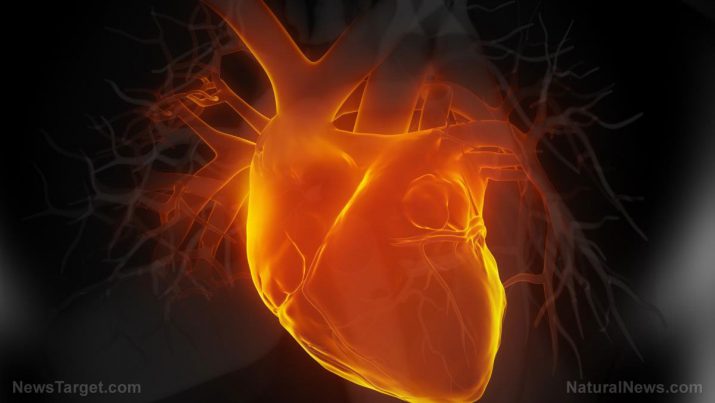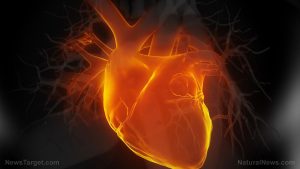
Coronary heart disease – causes, side effects and treatments at NaturalPedia.com
Monday, February 19, 2018 by Janine Acero
http://www.naturalpedia.com/coronary-heart-disease-causes-side-effects-and-treatments-at-naturalpedia-com.html

Coronary artery disease (CAD) is the most common type of heart disease and the leading cause of death in the U.S.
CAD happens when the arteries become hardened and narrow due to the buildup of cholesterol and fatty deposits called plaque on their inner walls. This buildup is called atherosclerosis. As it grows, it blocks the arteries, reducing the blood and oxygen flow to the heart muscle. This can lead to chest pain or a heart attack.

Known symptoms and risk factors for coronary heart disease
Often called the silent killer, CAD symptoms may occur quickly, sharply, and unexpectedly. These symptoms may lead to a heart attack or cardiac arrest.
When the heart is unable to pump enough blood to circulate in different parts of your body, you may experience all or some of the following symptoms:
- Tightness in the chest and chest pains (angina)
- Heart palpitations
- Shortness of breath
- Pain in the neck, arm, back, stomach or jaw, particularly on the left side of the body
- Weakness
- Fatigue
- Irregular heartbeat (arrhythmia)
- Dizziness
- Feeling faint or lightheaded
Your lifestyle and dietary choices are the main risk factors for CAD, particularly the following:
-
Smoking
- High cholesterol
-
High blood pressure
-
Diabetes
-
Lack of exercise
-
Obesity
-
Advancing age
- Family history of early CAD (having a close relative who developed the disease before age 50 to 55)
- Diets lacking in fiber, vitamins C, D, and E, and phytochemicals
Smoking more than doubles the risk of developing CAD and having a heart attack, as well as second-hand exposure.
For some people, a diet low in fish oils (omega-3 polyunsaturated fatty acids) also increases their risk for CAD.
Body systems harmed by coronary heart disease
CAD affects the heart, as well as other parts of the body when the blood flow is restricted, unable to meet the other body systems’ demands.
Food or nutrients that may prevent coronary heart disease
You can reduce your risk of getting CAD by making some lifestyle changes, such as:
- Eating a healthy, balanced diet
- Being physically active
- Giving up smoking
- Controlling blood cholesterol and sugar levels
Some foods are particularly helpful to the cardiovascular system. Include the following herbs in your daily diet to keep your heart healthy:
- Garlic – Garlic improves circulation and helps manage high blood pressure. It also reduces cholesterol levels, slowing the development of atherosclerosis.
- Ginger – Ginger can reduce cholesterol and has blood purifying properties and is common in heart tonics.
- Hawthorn – This herb is excellent for heart conditions as it helps increase blood flow to the heart and improves cardiac muscle contractions, which leads to stronger pumping action.
- Terminalia arjuna – Arjuna is an Ayurvedic herb that is considered a natural cardio-tonic and cardiac restorative. It strengthens the cardiac muscle, reduces arterial congestion and lowers blood pressure.
- Chinese hibiscus – Hibiscus flowers are known to contain antioxidants that help prevent bad cholesterol, which contributes to atherosclerosis. Tea that is made with this herb is also believed to help regulate high blood pressure.
- Turmeric – An active ingredient in turmeric called curcumin helps maintain heart health by reducing cholesterol and plaque buildup.
- Cayenne – Cayenne pepper contains a compound called capsaicin that is beneficial for treating heart and circulatory problems. It also helps reduce the risk of irregular heart rhythms and lowers cholesterol levels.
- Motherwort – Motherwort can relieve heart palpitations.
Old fashioned oatmeal also reduces cholesterol when eaten on a regular basis.
Treatment, management plans for coronary heart disease
The main treatment for people with CAD is bypass surgery. Patients undergoing bypass are put under general anesthetic and are not awake during surgery.
There are two bypass surgical procedures for CAD:
- Beating heart surgery – Also known as off-pump surgery, this procedure is done while the heart is beating. This often requires special equipment that allows the surgeon to operate on the heart while it is moving.
- Arrested heart surgery – This procedure is done through an incision in the chest while the heart is stopped and a heart-lung machine takes over the job of circulating the blood. This is also known as conventional bypass surgery.
Where to learn more
- Natural remedies to help treat or prevent coronary heart disease
- Barley Beta-Glucan Fiber Lowers Coronary Heart Disease Risk
- Meditation may improve cardiac risk factors in patients with coronary heart disease (press release)
- The Five Major Risk Factors for Coronary Heart Disease
- 6 Steps to Heal Coronary Heart Disease Naturally
Summary
Coronary artery disease is the most common type of heart disease and the leading cause of death in the U.S.
Often called a silent killer, CAD happens when plaque buildup (atherosclerosis) narrows the arteries and blocks the flow of blood and oxygen to the heart, leading to cardiac arrest or heart attack.
Lifestyle and dietary choices are the main risk factors for CAD, such as smoking, diets high in bad cholesterol, and lack of exercise. Advancing age and family history of CAD are also risk factors.
Sources include:
Tagged Under: Tags: coronary heart disease





